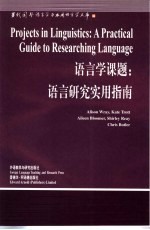图书介绍
语言学课题 语言研究实用指南 英文版PDF|Epub|txt|kindle电子书版本网盘下载

- (英)Alison Wray等著;严辰松导读 著
- 出版社: 北京:外语教学与研究出版社
- ISBN:7560023738
- 出版时间:2001
- 标注页数:312页
- 文件大小:13MB
- 文件页数:350页
- 主题词:
PDF下载
下载说明
语言学课题 语言研究实用指南 英文版PDF格式电子书版下载
下载的文件为RAR压缩包。需要使用解压软件进行解压得到PDF格式图书。建议使用BT下载工具Free Download Manager进行下载,简称FDM(免费,没有广告,支持多平台)。本站资源全部打包为BT种子。所以需要使用专业的BT下载软件进行下载。如BitComet qBittorrent uTorrent等BT下载工具。迅雷目前由于本站不是热门资源。不推荐使用!后期资源热门了。安装了迅雷也可以迅雷进行下载!
(文件页数 要大于 标注页数,上中下等多册电子书除外)
注意:本站所有压缩包均有解压码: 点击下载压缩包解压工具
图书目录
1 Introduction:starting on the right foot1
Choosing an area1
Getting organized3
Using resources5
Being a researcher7
Setting up data-based research9
Preface by Halliday14
Being streetwise:keeping on the right side of your assessor14
王宗炎序15
Preface by Chomsky18
2 Psycholinguistics19
PART I AREAS OF STUDY AND PROJECT IDEAS19
Textbooks and major journals20
Central themes and project ideas21
Modularity22
Themes in comprehension24
沈家煊序25
导读28
Themes in production30
Preface36
The units of normal processing36
Language and thought36
Approaches to research39
International Phonetic Alphabet39
3 First-language acquisition and development39
Terminology40
Textbooks and major journals40
The CHILDES database42
Things to think about42
Longitudinal case studies44
Central themes and project ideas44
Pre-linguistic development45
Over-and under-extension:lexical and semantic development46
Children s morphology47
Development of phonology and intonation47
Comprehension of complex grammatical structures48
Children s metalinguistic awareness48
Colour terms49
Carer language(or’child-directed speech )50
Conversational development51
Sources of variation in child language52
Literacy development52
4 Conversation analysis54
Textbooks55
Central themes and project ideas57
Major journals57
Scripted versus non-scripted conversation58
Radio and TV interviews59
The development of children s conversational skills59
Conversation and gender60
Language,power and hierarchy61
5 Second-language acquisition63
Terminology63
Textbooks and major journals65
Things to think about66
Central themes and project ideas66
Developmental sequences and the process of acquisition66
Comparison of L1 and L2 acquisition67
Language-learning targets67
Grammar-based and communication-based teaching68
Different concepts expressed in different languages70
Vocabulary acquisition70
The learner s approach and experience71
Interlanguage,error analysis and contrastive analysis71
Language assessment and testing72
Bilinguals,multilinguals and polyglots73
Foreign language teaching policy74
Effect of the year abroad76
Role of the social and political status of English as L276
6 Style in texts78
Textbooks and major journals79
Finding and approaching a text80
Central themes and project ideas80
Interpersonal function80
Sound patterns82
Lexical choice83
Grammatical structure85
Authorship86
Ideology and power86
7 Sociolinguistics88
Terminology and central concepts89
Textbooks and major journals90
Central themes and project ideas91
Types and causes of variation92
Quantitative approaches93
Social networks94
Qualitative approaches95
8 Accents and dialects of English99
Terminology100
Textbooks100
Other resources101
Which accent/dialect to choose102
Major journals102
What to look for in an accent103
What to look for in a dialect103
Possible angles and project ideas106
Comparing the speech of three generations106
Explaining why a variety has come about107
The political dimension of a variety108
Accent and dialect in literature109
Update study109
Comparison of two varieties110
Things to think about111
9 Structure and meaning112
Textbooks and major journals113
Central themes and project ideas115
Pragmatics115
Metaphor117
Sentence structure118
Lexicon and collocation119
Morphology and etymology122
Punctuation124
‘Correct’grammar124
10 Historical linguistics127
Textbooks,reference sources and major journals128
Central themes and project ideas131
Researching words131
Pronunciation and spelling134
History of English dialects135
The profile of a feature of English across time135
Socio-political trends and influences on English136
English as a world language136
Things to think about137
The influence of literacy on language137
11 Language and gender139
Terminology140
Useful skills and knowledge140
Textbooks140
Major journals142
Central themes and project ideas142
The history and development of language and gender as a branch of linguistics143
Attitudes towards male and female language143
Male-female differences in accent and dialect144
Differences in conversation and style of language use145
Explanations of difference147
Language and sexism148
Gender-differentiated language in first-language acquisition149
Language,gender and education150
Places to get data153
PART II TECHNIQUES FOR COLLECTING DATA153
12 Tape-recording date153
Audio or video?154
Ethics and legality154
Quality154
Practicalities154
Things to think about155
How much data do you need?156
Eliciting data from informants157
13 Experiments158
What does experimentation involve?159
Advantages of experimental research160
Disadvantages of experimental research160
Designing an experiment161
Things to think about163
Practice and fatigue effects164
Order effects164
Floor and ceiling effects164
Emergencies165
14 Questionnaires167
What is a questionnaire?167
What research areas can a questionnaire be used for?167
Subjects168
Handling personal information169
Presenting a questionnaire169
Designing a questionnaire171
Types of data173
Specific techniques177
Things to think about178
Relating the questionnaire to the study179
Written questionnaires179
Spoken questionnaires180
15 Interviews182
General procedures182
Approaches to interviewing183
Data elicitation183
Asking for intuitions183
Gathering general data for later analysis185
16 Observation and case studies186
Observation studies186
Advantages187
Disadvantages187
Things to think about188
Case studies189
Advantages190
Disadvantages190
Dealing with the results191
How to set up a case study191
PART III TOOLS FOR DATA ANALYSIS AND PROJECT WRITING195
17 Transcribing speech phonetically and phonemically195
The difference between phonetic and phonemic transcription195
A few notes on phonemes197
Hints on writing about pronunciation198
Checklist of phonemes199
18 Transcribing speech orthographically201
Basics201
Dealing with silence202
Dealing with complexity204
Dealing with obscurity and unusual pronunciations205
Use of conventional punctuation207
Dealing with pitch,emphasis,speed and volume208
Layout problems210
External events210
Other problems211
19 Using computers to study texts213
Corpora and other computer-readable textual materials213
Why you might want to study texts using a computer213
Compiling your own corpus:potential problems214
Corpora and other texts of English available for academic use214
How to get hold of a corpus216
Types of corpus annotation216
Linguistic analyses that can be done using computers and how to do them217
Programs that are available for text analysis220
Other applications of computers in relation to texts221
Textbooks222
20 The Data Protection Act224
What is the Data Protection Act?224
Registration226
Important note227
21 How to reference228
Basics228
The Harvard system232
The Humane system238
22 Plagiarism and how to avoid it241
What is plagiarism?241
How to avoid accidental plagiarism:some strategies242
An exercise in using published sources,creating a sophisticated account,and avoiding plagiarism242
23 Statistics255
Why use statistics?255
What can statistics do?256
Statistics and hypotheses258
Choosing statistical tests260
Textbooks262
Gaining confidence262
Key to the most common algebraic symbols used in basic statistics263
24 Using an abstracting journal265
What are abstracting journals?265
What abstracting journals are available?266
What to do266
25 Handy hints on writing good academic English268
Before you write268
As you are writing269
After you have written271
The uses of apostrophes271
Using punctuation272
Other common problems273
References274
Index293
文库索引304